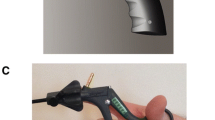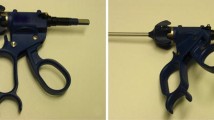Abstract
Background
Laparoscopic tool handles causing wrist flexion and extension more than 15° from neutral are considered “at risk” for musculoskeletal strain. Therefore, this study measured the impact of laparoscopic tool handle angles on wrist postures and task performance.
Methods
Eight surgeons performed standard and modified Fundamentals of Laparoscopic Surgery (FLS) tasks with laparoscopic tools. Tool A had three adjustable handle angle configurations, i.e., in-line 0° (A0), 30° (A30), and pistol-grip 70° (A70). Tool B was a fixed pistol-grip grasper. Participants performed FLS peg transfer, inverted peg transfer, and inverted circle cut with each tool and handle angle. Inverted tasks were adapted from standard FLS tasks to simulate advanced tasks observed during abdominal wall surgeries, e.g., ventral hernia. Motion tracking, video analysis, and modified NASA-TLX workload questionnaires were used to measure postures, performance (e.g., completion time and errors), and workload.
Results
Task performance did not differ between tools. For FLS peg transfer, self-reported physical workload was lower for B than for A70, and mean wrist postures showed significantly higher flexion for in-line than for pistol-grip tools (B and A70). For inverted peg transfer, workload was higher for all configurations. However, less time was spent in at-risk wrist postures for in-line (47 %) than for pistol-grip (93–94 %), and most participants preferred Tool A. For inverted circle cut, workload did not vary across configurations, mean wrist posture was 10° closer to neutral for A0 than B, and median time in at-risk wrist postures was significantly less for A0 (43 %) than for B (87 %).
Conclusion
The best ergonomic wrist positions for FLS (floor) tasks are provided by pistol-grip tools and for tasks on the abdominal wall (ventral surface) by in-line handles. Adjustable handle angle laparoscopic tools can reduce ergonomic risks of musculoskeletal strain and allow versatility for tasks alternating between the floor and ceiling positions in a surgical trainer without impacting performance.







Similar content being viewed by others
References
Park A, Lee G, Seagull FJ, Meenaghan N, Dexter D (2010) Patients benefit while surgeons suffer: an impending epidemic. J Am Coll Surg 210:306–313
Lowndes BR, Hallbeck MS (2014) Overview of human factors and ergonomics in the OR, with an emphasis on minimally invasive surgeries. Hum Factors Ergon Manuf Serv Ind 24:308–317
Berguer R, Smith WD, Chung YH (2001) Performing laparoscopic surgery is significantly more stressful for the surgeon than open surgery. Surg Endosc 15:1204–1207
Miller K, Benden M, Pickens A, Shipp E, Zheng Q (2012) Ergonomics principles associated with laparoscopic surgeon injury/illness. Hum Factors J Hum Factors Ergon Soc 54:1087–1092
Stomberg MW, Tronstad S-E, Hedberg K, Bengtsson J, Jonsson P, Johansen L, Lindvall B (2010) Work-related musculoskeletal disorders when performing laparoscopic surgery. Surg Laparosc Endosc Percutaneous Tech 20:49–53
Davis WT, Fletcher SA, Guillamondegui OD (2014) Musculoskeletal occupational injury among surgeons: effects for patients, providers, and institutions. J Surg Res 189(207–212):e206
Berguer R (1998) Surgical technology and the ergonomics of laparoscopic instruments. Surg Endosc 12:458–462
Berguer R, Gerber S, Kilpatrick G, Beckley D (1998) An ergonomic comparison of in-line vs pistol-grip handle configuration in a laparoscopic grasper. Surg Endosc 12:805–808
Nguyen NT, Ho HS, Smith WD, Philipps C, Lewis C, De Vera RM, Berguer R (2001) An ergonomic evaluation of surgeons’ axial skeletal and upper extremity movements during laparoscopic and open surgery. Am J Surg 182:720–724
Matern U, Kuttler G, Giebmeyer C, Waller P, Faist M (2004) Ergonomic aspects of five different types of laparoscopic instrument handles under dynamic conditions with respect to specific laparoscopic tasks: an electromyographic-based study. Surg Endosc Interv Tech 18:1231–1241
Youssef Y, Lee G, Godinez C, Sutton E, Klein RV, George IM, Seagull FJ, Park A (2011) Laparoscopic cholecystectomy poses physical injury risk to surgeons: analysis of hand technique and standing position. Surg Endosc 25:2168–2174
Sutton ER, Park A (2012) Ergonomics in Operating Room Design. The SAGES Manual, Springer, pp 45–59
Craven R, Franasiak J, Mosaly P, Gehrig PA (2013) Ergonomic deficits in robotic gynecologic oncology surgery: a need for intervention. J Minim Invasive Gynecology 20:648–655
Berguer R, Rab G, Abu-Ghaida H, Alarcon A, Chung J (1997) A comparison of surgeons’ posture during laparoscopic and open surgical procedures. Surg Endosc 11:139–142
Berguer R, Forkey D, Smith W (1999) Ergonomic problems associated with laparoscopic surgery. Surg Endosc 13:466–468
Trejo A, Doné K, DiMartino A, Oleynikov D, Hallbeck M (2006) Articulating vs. conventional laparoscopic grasping tools—surgeons’ opinions. Int J Ind Ergon 36:25–35
Tung K, Shorti R, Downey E, Bloswick D, Merryweather A (2015) The effect of ergonomic laparoscopic tool handle design on performance and efficiency. Surg Endosc 29:2500–2505
Majeed AW, Jacob G, Reed MW, Johnson AG (1993) Laparoscopist’s thumb: an occupational hazard. Arch Surg 128(3):357
Kano N, Yamakawa T, Ishikawa Y, Miyajima N, Ohtaki S, Kasugai H (1995) Prevention of laparoscopic surgeon’s thumb. Surg Endosc 9:738–739
Horgan L, O’riordan D, Doctor N (1997) Neuropraxia following laparoscopic procedures: an occupational injury. Minim Invasive Ther Allied Technol 6:33–35
Wolf JS Jr, Marcovich R, Gill IS, Sung GT, Kavoussi LR, Clayman RV, McDougall EM, Shalhav A, Dunn MD, Afane JS (2000) Survey of neuromuscular injuries to the patient and surgeon during urologic laparoscopic surgery. Urology 55:831–836
Lawther RE, Kirk GR, Regan MC (2002) Laparoscopic procedures are associated with a significant risk of digital nerve injury for general surgeons. Ann R Coll Surg Engl 84(6):443
Gofrit ON, Mikahail AA, Zorn KC, Zagaja GP, Steinberg GD, Shalhav AL (2008) Surgeons’ perceptions and injuries during and after urologic laparoscopic surgery. Urology 71:404–407
Riggle JD, Miller EE, McCrory B, Meitl A, Lim E, Hallbeck MS, LaGrange CA (2014) Ergonomic comparison of laparoscopic hand instruments in a single site surgery simulator with novices. Minim Invasive Ther Allied Technol 24(2): 68–76
Herring SR, Trejo AE, Hallbeck MS (2010) Evaluation of four cursor control devices during a target acquisition task for laparoscopic tool control. Appl Ergon 41:47–57
Loring B, Lemieux E-A (2010) User research improves laparoscopic instruments. Ergon Des Q Hum Factors Appl 18:18–23
Seagull FJ, George I, Ghaderi I, Vaillancourt M, Park A (2009) Surgical abdominal wall (SAW): a novel simulator for training in ventral hernia repair. Surg Innov 16:330–336
Derossis AM, Fried GM, Abrahamowicz M, Sigman HH, Barkun JS, Meakins JL (1998) Development of a model for training and evaluation of laparoscopic skills. Am J Surg 175:482–487
Fraser S, Klassen D, Feldman L, Ghitulescu G, Stanbridge D, Fried G (2003) Evaluating laparoscopic skills. Surg Endosc 17:964–967
Oriot D, Darrieux E, Boureau-Voultoury A, Ragot S, Scépi M (2012) Validation of a performance assessment scale for simulated intraosseous access. Simul Healthc 7:171–175
Morrow MM, Hurd WJ, Kaufman KR, An K-N (2010) Shoulder demands in manual wheelchair users across a spectrum of activities. J Electromyogr Kinesiol 20:61–67
McAtamney L, Corlett EN (1993) RULA: a survey method for the investigation of work-related upper limb disorders. Appl Ergon 24:91–99
Hart SG, Staveland LE (1988) Development of NASA-TLX (Task Load Index): results of empirical and theoretical research. Adv Psychol 52:139–183
Hart SG (2006) NASA-task load index (NASA-TLX); 20 years later. In: Proceedings of the human factors and ergonomics society annual meeting, Sage Publications, pp 904–908
Bingener J, Mohamed AO, Lowndes BR, McConico AL, Hallbeck S (2014) Modified NASA workload tool identifies physical and cognitive surgeon workload for laparoscopic procedures. J Am Coll Surg 219:e13
Ahmed S, Hanna GB, Cuschieri A (2004) Optimal angle between instrument shaft and handle for laparoscopic bowel suturing. Arch Surg 139:89–92
Uchal M, Brogger J, Rukas R, Karlsen B, Bergamaschi R (2002) In-line versus pistol-grip handles in a laparoscopic simulators. Surg Endos Interv Tech 16:1771–1773
Buckle PW, Jason Devereux J (2002) The nature of work-related neck and upper limb musculoskeletal disorders. Appl Ergon 33:207–217
Keir PJ, Bach JM, Hudes M, Rempel DM (2007) Guidelines for wrist posture based on carpal tunnel pressure thresholds. Hum Factors J Hum Factors Ergon Soc 49:88–99
Berguer R (1999) Surgery and ergonomics. Arch Surg 134:1011–1016
Van Veelen M, Kazemier G, Koopman J, Goossens R, Meijer D (2002) Assessment of the ergonomically optimal operating surface height for laparoscopic surgery. J Laparoendosc Adv Surg Tech 12:47–52
van Det MJ, Meijerink WJHJ, Hoff C, van Veelen MA, Pierie JPEN (2008) Ergonomic assessment of neck posture in the minimally invasive surgery suite during laparoscopic cholecystectomy. Surg Endosc 22:2421–2427
Plerhoples TA, Hernandez-Boussard T, Wren SM (2012) The aching surgeon: a survey of physical discomfort and symptoms following open, laparoscopic, and robotic surgery. J Robot Surg 6:65–72
Acknowledgments
The authors would like to acknowledge the support and participation of the surgeons involved in this study. We would also like to thank Mary, Ray, Laurie, and Pam for technical and administrative support. This study was funded in part by Stryker Endoscopy and by the Robert D. and Patricia E. Kern Center for the Science of Health Care Delivery.
Funding
Stryker Endoscopy, San Jose, CA (Yu, Lowndes, Morrow, Bingener, and Hallbeck); Mayo Clinic, Robert D. and Patricia E. Kern Center for the Science of Health Care Delivery (Yu, Lowndes, Morrow, and Hallbeck); Mayo Clinic, Department of Surgery Research (Bingener and Hallbeck); U.S. Department of Health and Human Services, National Institutes of Health, National Institute of Diabetes and Digestive and Kidney Diseases (K23 DK 93553) (Bingener).
Author information
Authors and Affiliations
Corresponding author
Ethics declarations
Disclosures
Drs. Hallbeck and Bingener completed this study with funding from Stryker Endoscopy. Dr. Bingener is supported through a research grant (NIDDK K23 DK 93553), specified research through Nestle, has received travel support from Intuitive Surgical, and serves on the Surgeon Advisory Board for Titan Medical. Drs. Yu and Morrow have research funding from Stryker Endoscopy. Bethany Lowndes is supported through research grants from AHRQ and Stryker Endoscopy. Dr. Kaufman has no conflicts of interest or financial ties to disclose.
Rights and permissions
About this article
Cite this article
Yu, D., Lowndes, B., Morrow, M. et al. Impact of novel shift handle laparoscopic tool on wrist ergonomics and task performance. Surg Endosc 30, 3480–3490 (2016). https://doi.org/10.1007/s00464-015-4634-7
Received:
Accepted:
Published:
Issue Date:
DOI: https://doi.org/10.1007/s00464-015-4634-7




